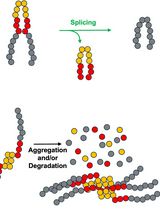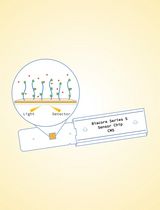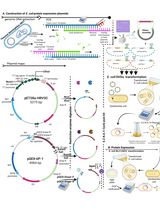- EN - English
- CN - 中文
Simple Methods for the Preparation of Colloidal Chitin, Cell Free Supernatant and Estimation of Laminarinase
胶体几丁质、无细胞上清液的简易制备方法及昆布多糖酶的测定
发布: 2021年10月05日第11卷第19期 DOI: 10.21769/BioProtoc.4176 浏览次数: 5004
评审: Khyati Hitesh ShahXin XuChhuttan L Meena
Abstract
Colloidal chitin (CC) is a common substrate used in research work involving chitin-active enzymes (chitinases). Cell free supernatant (CFS) is prepared from fermented broth. Preparation of CC and CFS usually involve large amounts of liquid, which must be separated from the solids. This necessitates the use of a large volume centrifugation facility, which may not be accessible to everyone. Filtration is a viable alternative to centrifugation, and several filter elements are described in the literature. Each of those elements has its own set of disadvantages like non-availability, high cost, fragility, and non-reusability. Here we describe the use of lab coat clothing material (LCCM) for the preparation of CC and CFS. For filtration purposes, the LCCM was found to be functional, rugged, reusable, and cost-effective. Also described here is a new method for the estimation of laminarinase using a laminarin infused agarose gel plate. An easily available optical fabric brightener (OFB) was used as a stain for the agarose plate. The laminarin infused agarose plate assay is simple, inexpensive, and was found to be impervious to high amounts of ammonium sulfate (AS) in enzyme precipitates.
Keywords: Colloidal chitin (胶体几丁质)Background
Separation of insoluble solids from liquids may be achieved by either centrifugation or filtration. The use of centrifugation for the preparation of colloidal chitin (CC) and cell free supernatant (CFS) has limitations as a large volume of liquids are involved (Hsu and Lockwood, 1975; Mitsutomi et al., 1995). Preparation of CFS from lab-scale and pilot-scale fermented broth is particularly challenging (Sarkar et al., 2010). Thus, a large capacity centrifuge machine (preferably refrigerated) with suitable rotor must be used (e.g., Sorvall BIOS 16). These facilities may not be available to researchers, especially in developing countries. Under these circumstances, filtration can be a viable alternative to centrifugation.
Most of the filter elements described in the literature (viz. filter paper, paper coffee filter, Miracloth, cheese cloth, etc.) suffer from one or more of the drawbacks listed below (Sandhya et al., 2004; Javaid and Ali, 2011; Murthy and Bleakley, 2012; Nidheesh and Suresh, 2015; Park et al., 2015): (1) Expensive (Miracloth); (2) Fragile (filter paper and paper coffee filter); (3) Non-reusable (filter paper and paper coffee filter); (4) Poor filtration rate (cheese cloth, filter paper, and paper coffee filter) and (5) Not readily available (paper coffee filter and Miracloth).
In this work, a 280 g per square meter (GSM) 65/35 polyester-cotton blend LCCM was used as a filter element. LCCM was found to be perfectly suitable for the preparation of CC. CFS was prepared from Streptomyces rimosus AFM-1 using a similar set of materials and is most suitable for organisms exhibiting pellet growth (viz. fungi and actinomycetes) (Koteshwara et al., 2021).
Laminarin (β(1→3)-glucan interspersed with β(1→6)-branches) is the long-term carbon storage polymer of glucose found in brown algae (Beattie et al., 1961; Graiff et al., 2016). Laminarinases ((1→3)-β-glucan hydrolase) are a type of hemicellulase that act upon and hydrolyze laminarin. They can be classified as either endo-type (EC 3.2.1.39) or exo-type (EC 3.2.1.58) based on the substrate hydrolysis pattern (Wu et al., 2018). The laminarinase enzyme is produced by a wide variety of organisms and plays an important role in natural ecosystems for the recycling of carbon (Graiff et al., 2016). Bacteria usually only transport substrates with a molecular mass of <600Da (Weiss et al., 1991; Grinter and Lithgow, 2020). Consequently, many marine bacteria produce extracellular enzymes like laminarinases to hydrolyze high molecular mass substrates (e.g., laminarin: 2,000-7,000 Da) (Yang et al., 2020). β-Glucan hydrolases are used in the food industry, medicine, and biotechnology (Qin et al., 2017).
Commercial laminarin used in the laboratory is usually sourced from either Laminaria digitata (Sigma-Aldrich L9634) or Eisenia bicyclis (TCI L0088). Interestingly, laminarin has similarities to the β-glucans found in the fungal cell wall. Thus, it is used to evaluate the anti-fungal β-glucan hydrolases produced by various organisms, especially the biocontrol agents (Scott and Schekman, 1980; Watanabe et al., 1989; De la Cruz et al., 1995; Aktuganov et al., 2008). Under these circumstances, detection and estimation of laminarinase enzyme assumes importance.
AS precipitation continues to be the most preferred method for the separation of proteins from CFS due to the following reasons (Wingfield, 2001; Duong-Ly and Gabelli, 2014): (1) It is inexpensive, simple, germicidal, highly soluble in water, and exerts a stabilizing effect on the precipitated proteins; (2) For the precipitation of native and non-recombinant proteins; (3) It can inhibit proteolytic activity; and (4) Precipitation of recombinant protein without an affinity tag or an unexposed affinity tag.
AS precipitation is a non-specific method. Thus, optimization of the AS concentration must be carried out to reduce the amount of contaminating proteins. AS interferes with most enzyme assays, thus the precipitates must be dialyzed before evaluation. A simple and rapid assay that provides results without the need for dialysis would ease the AS optimization task; this idea was the motivation for this research work (Koteshwara et al., 2021).
Plate assays for enzymes are inherently much simpler than liquid assays. This is due to their simple design, ability to evaluate multiple samples in a single plate, and the fact that they provide direct qualitative/ semi-quantitative results (Teather and Wood, 1982; Samad et al., 1989; Gulati et al., 1997; Meddeb-Mouelhi et al., 2014; Sawant et al., 2015; Patil and Chaudhari, 2017). We have developed a plate assay for laminarinase using a laminarin-infused agarose gel. Laminarin is a translucent substrate necessitating the use of a dye for the detection of zones of hydrolysis. An easily available OFB Tinopal CBS-X (Disodium 4,4'-bis(2-sulfostyryl) biphenyl) was tested as a stain and found suitable. The plate assay provided accurate, reproducible results even in the presence of a high concentration of AS (Koteshwara et al., 2021). Congo red is an extensively used dye for the detection of polysaccharide hydrolysis but is not recommended for use with laminarin gel plate assay due to poor contrast (Wood et al., 1988). Many wide-ranging and complicated methods can be found in the literature for the preparation of CC, CFS, and laminarinase plate assay. Simple alternatives to complex protocols are described here.
Materials and Reagents
Glass funnel plain (60° Angle and short stem) (Borosil, catalog number: 6140077)
Petri dishes (3.9” and 5.9” diameters) (Borosil, catalog numbers: 3165A77 [3.9”]; 3165081 [5.9”])
Conical flask with screw cap (250 ml capacity recommended) (Borosil, catalog number: 5021024)
Plastic tray (preferably polypropylene) (Tarsons, catalog number: 240090)
Cellulose membrane dialysis tubing (14 kDa cutoff) (Sigma-Aldrich, catalog number: D9652)
Steam indicator tape (3M, catalog number: 1322)
Dry heat indicator strip (HiMedia Laboratories, catalog number: LA812)
Laminarin derived from Laminaria digitata (Sigma-Aldrich, catalog number: L9634)
Shrimp chitin powder (HiMedia Laboratories, catalog number: RM1356)
(NH4)2SO4 (HiMedia Laboratories, catalog number: GRM1192)
KH2PO4 (HiMedia Laboratories, catalog number:GRM2951)
K2HPO4 (HiMedia Laboratories, catalog number: GRM168)
Yeast extract powder (HiMedia Laboratories, catalog number: RM027)
Malt extract powder (HiMedia Laboratories, catalog number: RM004)
Glucose (HiMedia Laboratories, catalog number: GRM016)
NaCl (HiMedia Laboratories, catalog number: GRM3954)
Agarose (HiMedia Laboratories, catalog number: MB002)
MgSO4·5H2O (Sisco Research Laboratories, catalog number: 85611)
FeSO4·7H2O (Sisco Research Laboratories, catalog number: 97868)
ZnSO4·5H2O (Sisco Research Laboratories, catalog number: 35243)
Tinopal CBS-X 99% pure (AksharChem, catalog number: AKSHAR1979)
37% w/w hydrochloric acid (Merck Life Science, catalog number: 1003172011)
65/35 polyester-cotton blend 280 GSM LCCM (generic purchased from local market or collected from an old laboratory coat)
Distilled water (prepared in-house)
Laminarin infused agarose gel (see Recipes)
Tinopal CBS-X OFB staining solution (see Recipes)
Chitin acid slurry (see Recipes)
CCMS broth medium (see Recipes)
Note: All materials were kept at room temperature, protected from excessive humidity.
Equipment
Microwave oven (Samsung, model: MS23F301TAK/TL)
Antibiotic Zonescale (HiMedia Laboratories, catalog number: PW297)
Glazed porcelain or plastic Buchner funnel with fixed perforated plate 6” diameter (Porcelain: Fisher Scientific, FisherbrandTM, catalog number: FB966J; Plastic: Cole-Parmer, DynalonTM, catalog number: WW-06128-10)
Rubber adapter for Buchner funnels (optional for use with vacuum pump) (generic)
Vacuum pump (optional) (Toshniwal Instruments (Madras), model: TDC6)
Magnetic stirrer and round magnetic stirrer bar with pivot ring 8 × 65 mm (REMI Sales and Engineering Ltd., Magnetic stirrer: model: 1ML; Magnetic stir bar: Tarsons, catalog number: 4115)
Autoclave or pressure cooker for sterilization (Autoclave: Osworld, model: JRIC-39; Pressure cooker: TTK Prestige., model: Popular 16L)
Glass stirring rod and plastic spatula
Plastic beaker 2 L with spout and handle (Sigma-Aldrich, BrandTM, catalog number: BR41012)
Buchner flask (>2 L capacity recommended) (Sigma-Aldrich, PyrexTM, catalog number: SLW1170/14D)
Stage micrometer and eyepiece graticule (Erma Inc., model: ESM11)
Microscope (Olympus, model: CX41)
Porcelain mortar and pestle (Sigma-Aldrich, CoorsTM, catalog number: Z247499)
Water distillation system (Borosil, catalog number: 3361-1.5 L)
Software
Java runtime environment (Oracle, https://www.java.com/en/)
Fiji (ImageJ) (Laboratory for Optical and Computational Instrumentation, University of Wisconsin at Madison, USA. https://imagej.net/Welcome)
Procedure
文章信息
版权信息
© 2021 The Authors; exclusive licensee Bio-protocol LLC.
如何引用
Koteshwara, A. (2021). Simple Methods for the Preparation of Colloidal Chitin, Cell Free Supernatant and Estimation of Laminarinase. Bio-protocol 11(19): e4176. DOI: 10.21769/BioProtoc.4176.
分类
微生物学 > 微生物生物化学 > 蛋白质
生物化学 > 糖类 > 多糖
生物科学 > 微生物学
您对这篇实验方法有问题吗?
在此处发布您的问题,我们将邀请本文作者来回答。同时,我们会将您的问题发布到Bio-protocol Exchange,以便寻求社区成员的帮助。
Share
Bluesky
X
Copy link













